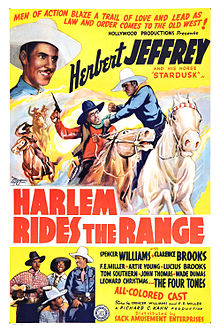Plot
Bob Blake (Herb Jeffries) and his sidekick Dusty (Lucius Brooks) are two cowboys riding across the countryside in search of adventure. They come across a ranch where it appears a murder has taken place but they find the victim of the crime, Jim Dennison (Leonard Christmas), still alive. Dennison is hiding in fear of his life after what had taken place at the ranch. Bob sees a picture of the rancher's daughter Margaret (Artie Young) and falls in love at first sight; he cannot stop talking about how beautiful the girl in the picture is. [1] Bob drops a glove when he leaves the ranch, which causes problems later.
The villain, Bradley (Clarence Brooks), wants to seize the ranch after terrorizing Dennison. Bob sets out to save Margaret and narrowly escapes a plot to frame him for the murder of one of the ranch foremen, Jim Connors (Tom Southern). Bradley uses Bob's dropped glove as part of the frameup. Bob is sent to jail, but is able to escape and tries to find Margaret. After a fight, Bob saves Margaret and they enjoy the romantic moment Bob had imagined when he first saw her picture. The ranch is saved; the story ends with Bob and Margaret together at last, and Bradley put in his place.
This page is based on this
Wikipedia article Text is available under the
CC BY-SA 4.0 license; additional terms may apply.
Images, videos and audio are available under their respective licenses.
